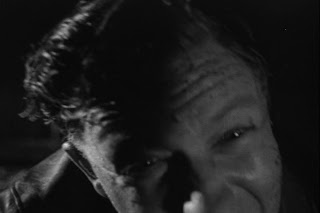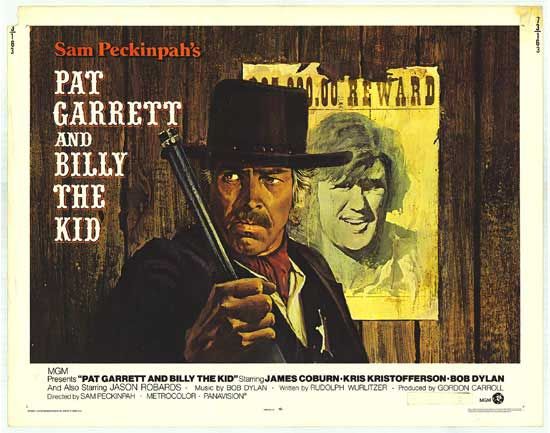The first in a series of posts on the films of Anthony Mann.

Reconfiguring and contextualizing their 1947 poverty row breakout hit T-MEN for the studios, Winnipeg, Manitoba born writer John C. Higgins, cinematographer John Alton, and director Anthony Mann teamed up with a noticeably larger budget for BORDER INCIDENT (1949), a semi-documentary police procedural with mirrored law enforcement protagonists dealing with the issue of illegal immigration from Mexico and into California, all sketched together with the use of a stentorian announcer filling us in on the broader, political incidentals up until now.
Opening with omniscient helicopter shots of canals and the Mexican-California border, Alton and Mann delight in the geometry of the rows and off-center patterns (a visual motif that will crop up – no pun intended – over the course of the film, most noticeably in the chiaroscuro-conducive slots of a mailroom seen over an hour later) and burgeoning landscape that would prove to be a precursor to the rugged terrain seen in the James Stewart westerns of Mann.

 Deep in the throes of World War II, it seems the United States’ own migrant workers were in short supply, so the government initiated The Bracero Program on August 4, 1942, enabling poor Mexican laborers to cross the border for a short period, with the U.S. intent on sending them back through the aid of incentives in Mexican bank accounts rather than legally allowing them to become citizens. Of course, some scheming individuals discovered loopholes, figured ways to smuggle Mexicans inside the U.S. and paid them less than the government was prepared to. This practice oftentimes led to several murders of the migrant workers following the theft of whatever the greedy entrepeneurs could steal back.
Deep in the throes of World War II, it seems the United States’ own migrant workers were in short supply, so the government initiated The Bracero Program on August 4, 1942, enabling poor Mexican laborers to cross the border for a short period, with the U.S. intent on sending them back through the aid of incentives in Mexican bank accounts rather than legally allowing them to become citizens. Of course, some scheming individuals discovered loopholes, figured ways to smuggle Mexicans inside the U.S. and paid them less than the government was prepared to. This practice oftentimes led to several murders of the migrant workers following the theft of whatever the greedy entrepeneurs could steal back.
BORDER INCIDENT is the tale of two law enforcement agents – Jack Bearnes (George Murphy, of William A. Wellman’s BATTLEGROUND) of the U.S. Immigration and Naturalization department, and Pablo Rodriguez (a baby-faced Ricardo Montalban, fresh off a series of MGM musicals in what was his first dramatic performance) of the Mexican equivalent of the F.B.I. Their job is to infiltrate the shadowy organizations in order to find out just how these crooked entrepreneurs and dishonest farmers oper ate, Rodriguez posing as a disgraced Bracero not content on waiting any longer for the legal channels to allow him to enter the United States, and Bearnes as a common felon who has stolen more than four-hundred blank immigration slips (and thus, enticing the villains with something they desperately want and need). The tough-guy authority of Bearnes and Rodriguez’s subtle understanding of his people's plight make for a clash of engaging personalities, though a friendship is established by a brief throwaway line of another case the two worked on in Texas (and in a sly comment for a film that doesn’t have any smoldering females to speak of, both detectives are quick to agree on the attractiveness of a female caught up in that previous case; if this film can’t showcase any striking women, at least it can speak of beauties almost too gorgeous to be seen).
ate, Rodriguez posing as a disgraced Bracero not content on waiting any longer for the legal channels to allow him to enter the United States, and Bearnes as a common felon who has stolen more than four-hundred blank immigration slips (and thus, enticing the villains with something they desperately want and need). The tough-guy authority of Bearnes and Rodriguez’s subtle understanding of his people's plight make for a clash of engaging personalities, though a friendship is established by a brief throwaway line of another case the two worked on in Texas (and in a sly comment for a film that doesn’t have any smoldering females to speak of, both detectives are quick to agree on the attractiveness of a female caught up in that previous case; if this film can’t showcase any striking women, at least it can speak of beauties almost too gorgeous to be seen).
Rodriguez, almost immediately after going undercover, befriends a comparable migrant case in Juan Garcia (James Mitchell), a six-week veteran of the dehumanizing process of standing in line awaiting an affirmative answer from the people who decide on which “Braceros” are allowed access to the United States. Married with children, Juan Garcia has a lot more to lose should he be taken advantage of -- not to mention the added insult of his criminal superiors taking overpriced deductions for both food and shelter. Still, he decides to cross with Rodriguez anyway.
After tracking down some venal-minded citizens who are willing to set up their transport, Mann presents us with one of the cleverest scenes in the picture, as a woman dressed in the style of a palm reader inspects Rodri guez’s hands. In an all-too-quick assessment, she suspects that he is lying by the fact that no calluses appear on the skin of his supposedly migrant worker hands. Rodriguez gets the okay anyway, after quick conniving and some fierce deliberation by the powers-that-be, but such deceitful appearances and table-turnings aren't common in the film, and it makes for a unique bit of overturning a stereotype.
guez’s hands. In an all-too-quick assessment, she suspects that he is lying by the fact that no calluses appear on the skin of his supposedly migrant worker hands. Rodriguez gets the okay anyway, after quick conniving and some fierce deliberation by the powers-that-be, but such deceitful appearances and table-turnings aren't common in the film, and it makes for a unique bit of overturning a stereotype.
Rodriguez and Juan Garcia then make a precarious entrance into U.S. territory on the back of a flatbed truck, hidden underneath a layer of hay, and driven to the contemplation of their respective futures -- Rodriguez worrying about his case, and Juan Garcia, his family --brought on by the death of an elderly member of their burrowed-in crew.
Bearnes takes a wiseacre approach to his newfound identity, allowing the big daddy of the syndicate, Owen Parkson (Howard Da Silva), to make his presence, but to never let him have the upper hand; his playful snatching away of the dart gun from Parkson letting the latter know that Bearnes is not one to be openly obsequious, and he can more than stand his ground. Da Silva’s bulbous appearance does wonders for his living-off-the-land persona here, a man getting rich off the tragic exploitation of others. He has a number of minions answering to him, namely Zopilate (Arnold Moss) and Chuchillo (Alfonso Bedoya, his credit in the trailer reading “Remember  Him From THE TREASURE OF THE SIERRA MADRE?”), two slicksters who do all of the man’s dirty work.
Him From THE TREASURE OF THE SIERRA MADRE?”), two slicksters who do all of the man’s dirty work.
Bearnes’ denouement is positively astonishing, especially when considering the time in which this was made: in another reverberation of T-MEN, Rodriguez is forced to confront the demise of his assigned partner as a tractor driven by Da Silva’s underlings virtually obliterate his body while he barks out for mercy. Mann builds the intensity here by depicting Bearnes crawling ever so closely to the frame, juxtaposed with high-angled shots of the rudders that will seal his fate. There is a baroque corrosiveness in this explicit death that almost foreshadows a similar white-nuclear heat seen in Robert Aldrich’s KISS ME DEADLY.

Alton and Mann capture the villains mostly in hard-lit close-ups, and the skillful compositions play around with focus, allowing for immediate foreground features (usually on the left side of the frame) to be contrasted with the thrown-into-sharp-relief background details. Most often we’ll see characters snaking around the corners of the left side of the frame as the villains jostle about frantically on the right, searching for either Rodriguez or
Bearnes or whomever. There is also a doubling-up of gestures signaling an equanimity between nations, as seen in the still below of Rodriguez and
 Bearnes
Bearnes shaking the hands of their superiors and the final shot (before the dissolve) of the American and Mexican flags hanging in equal balance as Mexican agent Rodriguez is celebrated by his American compatriots. Alton has the well-earned reputation as the master of film
noir lighting, and even if the film in question scarcely falls into film
noir territory -- in character, location, or even plot -- Alton and Mann still mine the shadow-play for all its worth in this, their fifth of six collaborations. Mann’s choice of blocking here is to include as many people in the scene as possible, cramming everyone into tight medium shots for prolonged expository dialogue scenes.


Perhaps a trifle inconsequential in comparison to their Eagle-Lion films like T-MEN and especially RAW DEAL, BORDER INCIDENT still shows Mann getting accustomed to the luxuries of being under contract while accommodating some lesser stars in this MGM release. I’m not about to suggest that it’s simply a watered down big-studio indirect remake of T-MEN without the pugnacity or immediate kick of the original, because the mere handling of landscape here gave Mann a chance to get acclimatized to composing and dealing with the open-spaces that he’d soon be shooting with leading man James Stewart. Mann captures the determined focus inherent in two law enforcement men with no home lives and very little information -- other then the criminal cases that defines their being -- but there’s still a carefree attitude in the professionalism depicted than that in the heroes of Howard Hawks. Mann’s men, at least in his noirs and police procedurals, navigate the waters of their predicaments with a combination of defiant stability, a swagger in their step, and a tongue in their cheek.
Labels: Anthony Mann, Border Incident, John Alton
 I finally found a copy of this long out-of-print tome comprised of Lewis' sole foray in teaching filmmaking -- at USC, 1967 -- and felt the need to relate: this is simply the best filmmaking book I've ever read.
I finally found a copy of this long out-of-print tome comprised of Lewis' sole foray in teaching filmmaking -- at USC, 1967 -- and felt the need to relate: this is simply the best filmmaking book I've ever read.



 Reconfiguring and contextualizing their 1947 poverty row breakout hit T-MEN for the studios, Winnipeg, Manitoba born writer John C. Higgins, cinematographer John Alton, and director Anthony Mann teamed up with a noticeably larger budget for BORDER INCIDENT (1949), a semi-documentary police procedural with mirrored law enforcement protagonists dealing with the issue of illegal immigration from Mexico and into California, all sketched together with the use of a stentorian announcer filling us in on the broader, political incidentals up until now.
Reconfiguring and contextualizing their 1947 poverty row breakout hit T-MEN for the studios, Winnipeg, Manitoba born writer John C. Higgins, cinematographer John Alton, and director Anthony Mann teamed up with a noticeably larger budget for BORDER INCIDENT (1949), a semi-documentary police procedural with mirrored law enforcement protagonists dealing with the issue of illegal immigration from Mexico and into California, all sketched together with the use of a stentorian announcer filling us in on the broader, political incidentals up until now.
 Deep in the throes of World War II, it seems the United States’ own migrant workers were in short supply, so the government initiated The Bracero Program on August 4, 1942, enabling poor Mexican laborers to cross the border for a short period, with the U.S. intent on sending them back through the aid of incentives in Mexican bank accounts rather than legally allowing them to become citizens. Of course, some scheming individuals discovered loopholes, figured ways to smuggle Mexicans inside the U.S. and paid them less than the government was prepared to. This practice oftentimes led to several murders of the migrant workers following the theft of whatever the greedy
Deep in the throes of World War II, it seems the United States’ own migrant workers were in short supply, so the government initiated The Bracero Program on August 4, 1942, enabling poor Mexican laborers to cross the border for a short period, with the U.S. intent on sending them back through the aid of incentives in Mexican bank accounts rather than legally allowing them to become citizens. Of course, some scheming individuals discovered loopholes, figured ways to smuggle Mexicans inside the U.S. and paid them less than the government was prepared to. This practice oftentimes led to several murders of the migrant workers following the theft of whatever the greedy 








 My LP Collection
My LP Collection












